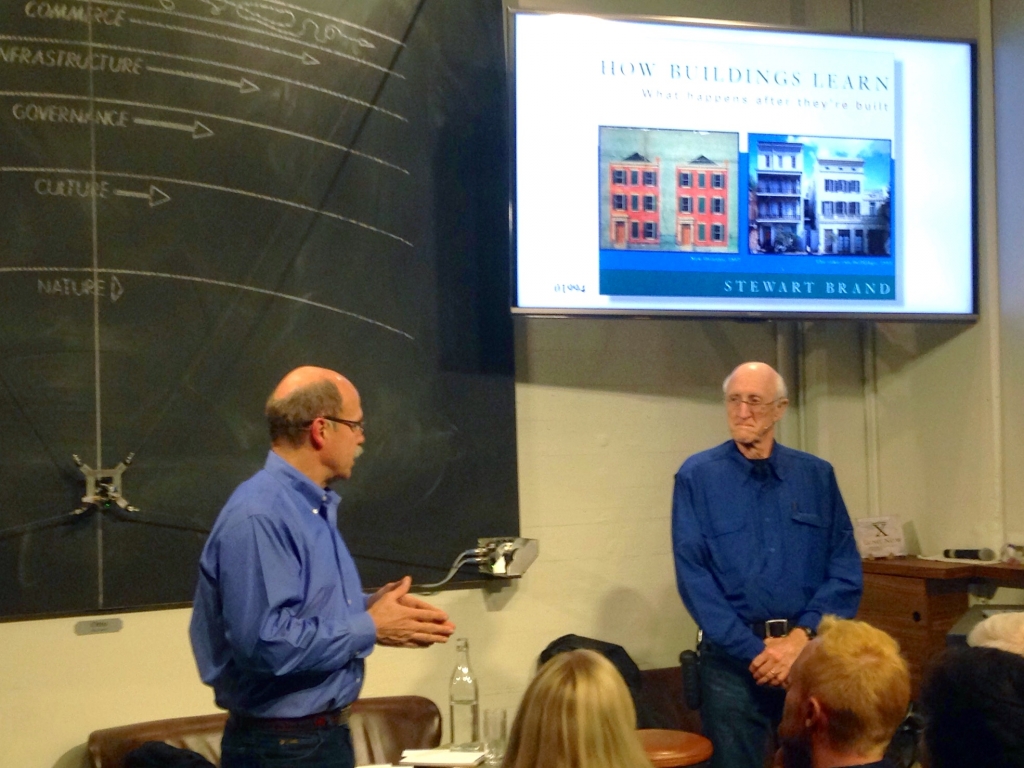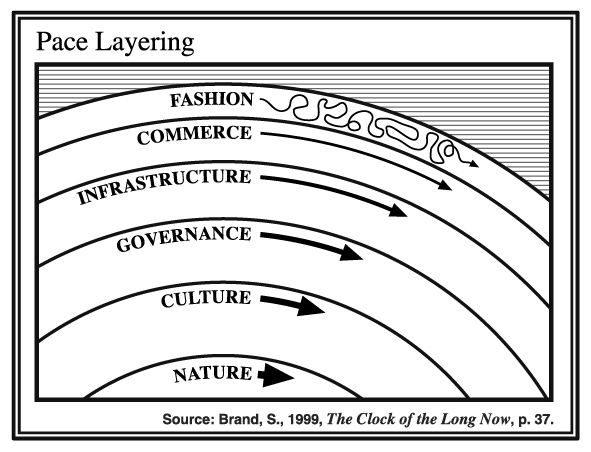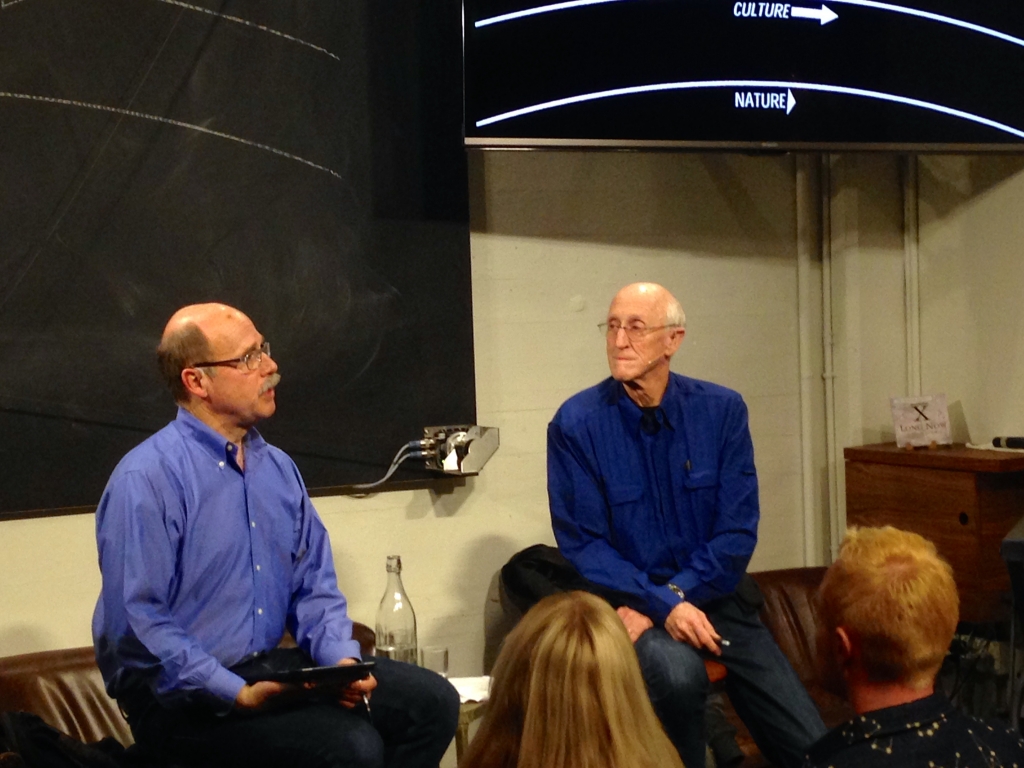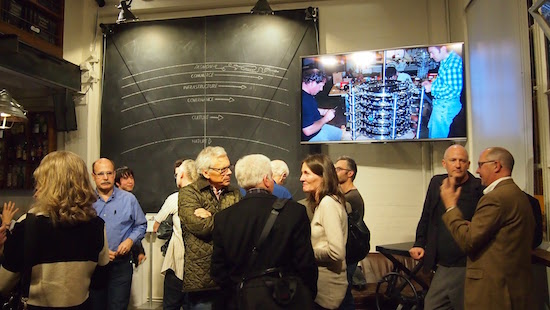On January 27, 02015 Long Now Foundation founding Board members Stewart Brand and Paul Saffo spoke at Long Now’s San Francisco venue The Interval about Pace Layers Thinking to a sold out crowd.


Stewart Brand and Paul Saffo — photos by Ian Kennedy
This was the 17th event in our Conversations at The Interval series since it began in May 02014. We informally call these “salon talks” due to their small size (relative to our SALT series) which allows our speakers and audience to meet and continue the discussion after the microphones are turned off.
It’s only the second time we’ve posted audio from an Interval talk. We’re proud to share this talk by two of our founding Board members.

Stewart introduced pace layers in The Clock of Long Now (01999). In the book he credits Freeman Dyson and Brian Eno, amongst others, for influencing his thinking on intra-societal tiers that move at differing speeds. At The Interval he went deeper into the origins of the idea, citing the concept of “Shearing Layers” by architect Frank Duffy as a precursor to pace layers. Stewart featured Duffy’s idea in his 01994 book How Buildings Learn: What Happens After They’re Built.

The beginnings of the concept can be found in this excerpt from How Buildings Learn:
To change is to lose identity; yet to change is to be alive. Buildings partially resolve the paradox by offering the hierarchy of pace – you can fiddle with the Stuff and Space Plan all you want, while the Structure and Site remain solid and reliable.

How Buildings Learn was influential in surprising ways. It was embraced for its applicability to systems thinking and software design amongst other things. And pace layers continues to be utilized as a framework for understanding many different kinds of complex, overlapping systems. Here’s a recent example:

Stewart shared an amazing artifact: a preliminary sketch of the pace layers diagram dating to December 01996. He drew it after discussions with Brian Eno. It includes a couple of the final edits which he mentions in his talk: the top layer was changed to Fashion from “Art”, at Eno’s insistence. And “Government” is here annotated with “Governance” which it would become in the final version.

In The Clock of the Long Now Stewart presents the diagram and lays out the pace layers concept in a 6-page chapter. He draws parallels to natural systems. He cites numerous sources that have informed his thinking. It’s remarkably efficient in presenting this idea, managing to be dense and readable at the same time.
While this Interval talk is a great introduction, if you are intrigued by pace layers then you should read the book. It is 200 pages long and is also a history of The Long Now Foundation and our signature project the 10,000 Year Clock. The book also features probably the most entertaining correspondence with the Interval Revenue Service that you will ever read.
In Pace Layers the relationship between layers is key to the health of the system. More specifically, as both Stewart and Paul point out, the conflicts caused by layers moving at different speeds actually keeps thing balanced and resilient. Paul calls this “constructive turbulence.” Stewart’s slide details how fast (upper) and slow (descending) layers interact.

Paul Saffo teaches pace layers in his forecasting classes at Stanford. He compared the speed of change in Silicon Valley to the slow shifting of the San Andreas Fault below. In fact he sees the Valley as having its own particular ecosystem of pace layers forming a standing vortex (akin to the eye of Jupiter). For those of us here in the Bay Area: “We all live on von Kármán vortex street.”

Paul called on a couple people in the audience to speak about how they use pace layers. Customer feedback, as it were. First up was Andrea Saveri who uses pace layers in futures education. For the 14 to 21 year-old students she works with, it provides a concrete way to think about time horizons, abstract thinking and the long-term future.
Peter Leyden was a colleague of Stewart’s at Global Business Network (GBN) around the time pace layers was published. Today, he noted, Culture and Nature are accelerating (driven by technology and climate change, respectively) but Governance isn’t responding. Even as the layers move below it, it’s not innovating.
Stewart had an answer for that. Look to cities and city-states (Singapore) which are less ideological and may be the change agents in Governance that are needed.

“This is a data free document” Stewart replied to a data-specific audience question. And maybe that lack of hard data has aided its longevity and versatility. It’s a framework, a way to look at issues in a society; or it can be projected on other systems. The lines are not hard lines; borders between layers are turbulent zones “where the action is”. But it’s not tied to “facts” which may turn out to have expiration dates.

Here’s how Stewart introduced pace layers back in 01999:
I propose six significant levels of pace and size in the working structure of a robust and adaptable civilization. […] In a healthy society each level is allowed to operate at its own pace, safely sustained by the slower levels below and kept invigorated by the livelier levels above.
He put forward pace layers as an ideal model, knowing that no society made of humans will operate perfectly to plan. After a decade and a half of continued use, the model seems to have garnered overwhelmingly positive feedback. It continues to be a useful bridge to long-term thinking. Its conceptual outline has been applied successfully to many areas of human activity. Maybe we should no longer call it “an idea.” And call it wisdom instead.

We hope you’ll listen to this talk in full and tell us what you think of the Conversations series. We’d like to make more audio and video of these events available in the future. Long Now is looking for grants and sponsorships to underwrite the production and distribution of these talks on a wider scale. Please let us know if you have ideas on that.

Photos by Julie Momméja unless otherwise noted
Thanks to Rhonda Evans (Monitor Institute) for her notes